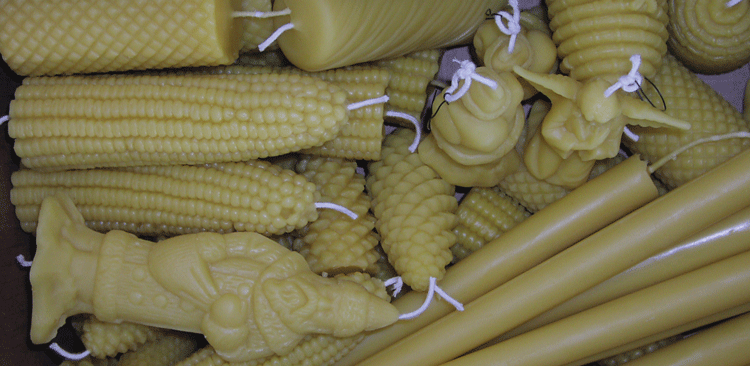Swammerdam’s Apprentice
Beeswax. What Is It?
The main constituents and the physical properties of beeswax.Wax is a hydrocarbon – contains the elements carbon, hydrogen and oxygen. It contains about 300 different chemicals.
Major components of a typical beeswax:
- Monohydric alcohols 31%
- Fatty acids 31%
- Hydrocarbons 16%
- Hydroxyl acids 13%
- Diols 3%
- Other (propolis, pollen, …) 6%
Physical properties of beeswax:
- Solid at room temperature
- Melts at 64°C
- Solidifies at 63°C
- It has a nice aroma (acids, alcohols, esters – volatiles)
- Specific gravity = 0.95. It floats in water and sinks in alcohol.
- It is not soluble in water.
- It is water repellent, used as water proofer – wax jackets and waxed threads.
- Slightly soluble in alcohol. Quite soluble in the higher order alcohols.
- It is soluble in chloroform, benzene, toluene, petrol, . . .
- It is brittle when cold.
- Malleable and plastic at 32°C
- It can remain stable for thousands of years.
- It is combustible, giving CO2 and H2O plus heat and light.
How Do I Make A Show Sample?
Purification.
- The wet cappings can be put in muslin bags (balanced) and spun in the extractor to recover as much honey as possible.
- I wash them in a little soft water to remove most of the honey and this can be used to feed some colonies – no waste.
- Rinse the cappings a few times in soft water. Hard water causes saponification with the calcium in the hard water – gives a bloom to the wax.
- For show the best wax comes from fresh cappings.
- Spread the cappings out on a white cloth and pick out any discoloured bits or foreign bodies – bee parts, propolis etc.
- The wax must be filtered through fine muslin. Place cappings in fine muslin cloth and tie it off.
- Place this in a jacketed hot water heater – when all of the wax is melted lift out the muslin slowly – reasonably pure wax will be left floating in the water.
- Filter this hot wax through fine filter paper to remove any further impurities, some use fine filter paper.
- Other methods can be used – solar extractor – steam boiler – or steam jacketed wax press.
- Do not use iron or copper vessels – stainlessless is preferred.
Mold
- Buy a mold of oven proof glass (Pyrex), free of internal blemishes and reserve for wax molding only.
- Check size of wax block from the show schedule.
- Put the appropriate volume of soft water in the mold and mark this level on the outside.
- Wash, with unscented detergent, and dry the mould.
- Heat the purified wax up to 70°C.
- Rub two to three drops soft water with two to three drops of unscented detergent all over the inside of the mold – to act as release agent.
- Place the mold in another larger Pyrex container with water at 66°C.
- Momentarily stand the heated wax container in a shallow tray of iced water – to congeal any dirt that may be in the bottom.
- Pour the molten wax into the mold, avoiding any air bubbles, up to the mark.
- Place a preheated lid on the mold.
- Allow to cool slowly, insulate with newspapers.
- Put the lot into the oven or the range when going to bed.
- The following morning submerge the mold in container of cold water – this releases the wax block.
- Smoothen off the edges and polish the surface with a silk cloth.
- The process will have to be repeated over several nights to get a block good enough for show exhibition.
- When you do get a good one – wrap it up well – put it in a plastic container and mind it.









